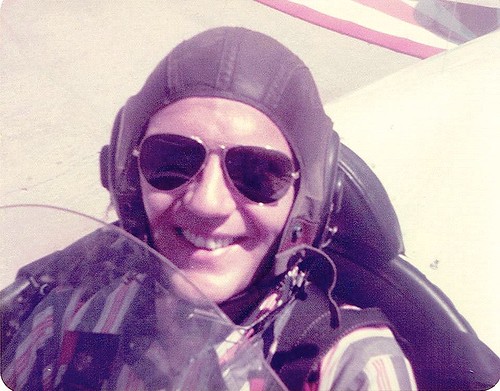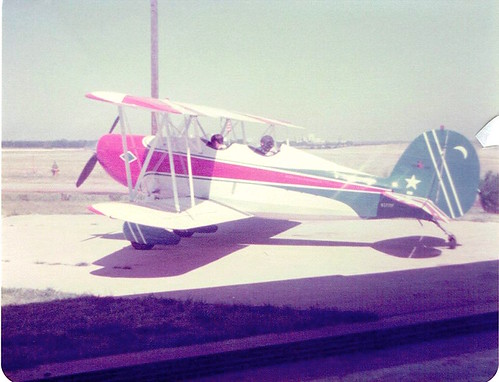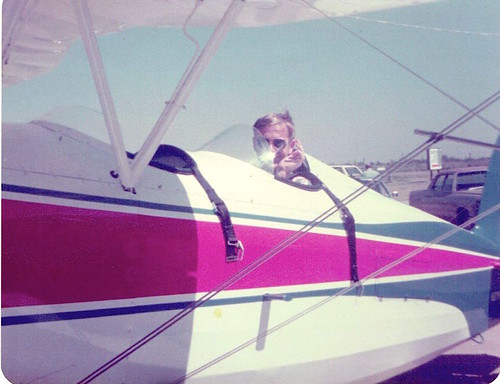I wrote this post in 2014. A reader who knew both of the men I wrote about left a comment this morning and I decided to move Taildragger Tales back to the top of the blog. —Paul
I found some faded and blurry photos of the Great Lakes biplane I used to fly, and, as old photos always do, they brought back memories.

In 1977, while I was an Air Force T-37 instructor pilot at Vance AFB in Enid, Oklahoma, I started a civilian flying training program at the local airport, thinking I might want to fly for the airlines some day. The fixed base operator at Woodring Field, Bill Sellers, ran a well-regarded flight school, and I earned my certified flight instructor rating in one of his airplanes. A month after I became a CFI, Bill added a Great Lakes biplane to his stable and decided to offer a course in aerobatics.
I was Bill’s first aerobatic student. After finishing the course I went to work on the weekends as one of Bill’s CFIs, teaching aerobatics and earning the occasional paycheck from the back seat of the Great Lakes. Snap rolls, outside loops, Cuban 8s, hammerheads, you name it … I flew many of these maneuvers in the T-37 at Vance AFB, but doing aerobatics in an open biplane, with my head out in the breeze, was another order of fun altogether.

The Lakes demanded your full attention on landing. As a taildragger, its center of gravity was behind the main gear, and if you didn’t work the rudder to keep the tail behind you it would try to get out in front. Swapping ends in this manner is called a ground loop. It’s an ever-present danger in taildraggers, especially during crosswind landings.
One day during my checkout program, Bill Sellers’ son Rusty, who was my instructor that day, decided he’d better land the Lakes himself since tower was calling a 13-knot crosswind, right at the plane’s limit. Sure enough, he ground-looped it. It happened in the blink of an eye, but I remember having time to think “Thank god I didn’t do that!” Bill Sellers was waiting for us with death in his eyes as we taxied up to the FBO a few minutes later, fabric hanging from the bottom of a bent wingtip.
Well, that was embarrassing, but hardly life-threatening, and Bill had the wing repaired in no time. The second time something bad happened in the Great Lakes, I was at the controls, oblivious to the danger I was in.
I was still in training, this time with Bill as my instructor. He was in the front seat pretending to be a student while I practiced teaching how to do snap rolls from the rear seat. A snap roll is a violent maneuver … “snap” is exactly the right word for it. You yank the stick all the way back and slam in full rudder in the desired direction of the roll. The plane whips into a fast roll, well in excess of 360 degrees a second, and halfway through you slam in full opposite rudder and full forward stick to snap it back into level flight. I probably did five snap rolls, one after another, until Bill and I were both happy I had the maneuver and teaching technique down. After practicing some other aerobatic maneuvers we flew back to Woodring Field.
Aerobatic maneuvers are hard on an airplane, even one designed for aerobatics, so I always gave the plane a good look-over afterward. That day, walking around the front of the Lakes, I noticed a half-circle gouge on the front of the engine cowling, right behind the propeller spinner. It looked like the engine had twisted to one side during flight, allowing the back of the spinner to rub against the cowling. “Bill,” I said, “what’s this?” We unbuttoned the engine cowling and took it off, and discovered to our horror that two of the four motor mounts had broken during our flight, probably from side-to-side forces generated while I was doing snap rolls.
Perhaps that doesn’t sound all that big a deal. Trust me, it was. With two motor mounts broken and doubled stress on the remaining two, another snap roll might have caused the engine and propeller to rip away from the front of the airplane. If the spinning prop didn’t chop up a wing … or the two guys sitting right behind it … the sudden absence of several hundred pounds from the nose would have turned the Great Lakes into an unflyable basket of wood and fabric, and we’d have certainly had to bail out … if, that is, we could have freed ourselves from the tumbling wreckage.
Bill and I were very quiet after that post-flight inspection. By the following weekend Bill had had the motor mounts replaced and the cowling repainted, but neither of us ever practiced snap rolls again, and I didn’t teach them once I was an instructor myself.

Like cats and their proverbial nine lives, pilots have an allotted number of close calls. Not nearly as many as cats get, though. Some of us get only one, some get three or four. Once you use them up you’re gone. I’m one of the lucky ones, because I’ve lived to tell about three close calls. This was the first one. I’ll tell you about the other two some day.
Thanks for bringing me up to date on Mr. Sellers. I was an airman and aero club manager at Vance in mid ’60s. Got my CFI with Mr. Sellers. Later in the late ’70s, not long after Rusty had died, I saw Mr. Sellers down in OKC with his Great Lakes. He took me out in it and did some fun acro. A super nice man and family.
Roger, thanks for checking in. Rusty was about my age and I didn’t know he had died. I’m sorry to hear it. I’d love to visit Woodring and Vance again some day!
Hi Paul. I never met Rusty. However, when I was hanging out at Sellers’ AViation in ’66 and ’67, Bill spoke of him frequently. I knew Bill was very proud of Rusty. When I met Bill ten or so years later in OKC, Bill said Rusty had been killed in an aircraft accident. Bill was extremely sad, and I did not ask questions, always assuming it had been a military accident. Several years ago, while researching something about Vance, I saw Rusty mentioned. It mentioned his death. If I’m remembering correctly, Rusty was a passenger on a charter seaplane flying out of south Fla or somewhere down there. It crashed killing Rusty.
I was a bit unique in the Vance aero club, being the only enlisted member. I got my commercial with the club, my instructors being T-38 IPs, but also civilian CFIs. For my CFI training, I went to Bill at Woodring. I returned to the VAFB aero club, and as an A1C (E4) was then checking out and approving flights in the club planes for some of the base T-37 and 38 IPs. I felt a bit foolish..but some of them definitely needed a little dual when they hopped into a C172. Enjoyed it all very much. Owe a lot to the base and to the USAF. I continued getting ratings with VA money after my USAF time, 4 year enlistment.
I was an ATC kinda guy in the USAF and after discharge went to work as a controller for the FAA. Retired from that after 34 years including Los Angeles and O’Hare. I retired out of Nashville 18 years ago having been a supervisor and assistant manager there.
I’m a taildragger guy. I first soloed in an Aeronca in ’59 while in HS out of Torrance Calif. And I still have an Aeronca Chief hangered locally in Shelbyville, TN. I even keep my CFI current but don’t use it for much except an occasional flight review for friends.
I thought of Mr. Sellers again a few years ago when my hanger neighbor bought a Great Lakes.
Reference Vance, visited a year ago. My wife and I met at Vance. She was a civilian employee there. The base always meant a lot to us because of that. When our 50th was approaching last year, I contacted the base public affairs office requesting a tour. I explained that I was a controller at Vance, my wife and I had met there, and our 50th was approaching. I told them I then served a civilian career with FAA. The base was fantastic. They provided us with a personal escort who let us just drive all over reminiscing. Then he took us to the ATC facilities, both the tower and the radar facility. They were fantastic,each facility having prepared for our visit again giving us a VIP visitor welcome. On the base, some things have changed but much remains the same. The visit was very meaningful for both of us.
And that’s probably a lot more than you ever wanted to know about that! roger
Great reading, Roger, and it brings back many memories. I’ll share your comments with our daughter Polly, who was born in Enid when I was instructing in T-37s with the 8th FTS. Thanks for writing!
Paul. Gosh darn. This got me thinking about all of that and Mr. Sellers. I’ve got to share just a few more tales about him.
As he trained me for my CFI and the spin requirements for the rating, he didn’t have me just do initial spin entry recognition and recovery. He had me do full 4 to 6 turn spins and then do an accurate recovery on a specific point on the ground, which I tried to do over and over as the world whirled below me, until I finally got it right. It did give this fairly low time and young airman some much better confidence as an aviator.
On evening late I was on duty at the Vance radar facility. We were the ATC facility for the civilian traffic around there also. Mr. Sellers was inbound to WDG in his C182. The weather was low IMC, and the only approach available back then was a no DME VOR approach. I was so proud to be vectoring Mr. Sellers for the approach, and then provide him with mile by mile distance remaining until he finally broke out. I even had someone else call Mrs. Sellers on the phone and give her this progress report on Bill. I walked tall after being able to help Mr. Sellers!
And last thing. In ’67, my Dad was flying his Mooney Mite from Calif to N.C. He did a fuel stop at WDG. I met him at the airport. Mr. Sellers was there. I had been telling my Dad how much Mr. Sellers had been helping me. After fueling the Mite, my Dad insisted that Mr. Sellers go take it for a flight. It was a snug fit for Bill, but he did. I was a smiling and proud son at that point. Roger
Great story, Skid. Hopefully you won’t need to use any more of those ‘nine lives’ for awhile. What have you been flying lately in Arizona? Mary and I fly down from Seattle to Long Beach, CA in our Warrior for our kids and grandkids often, and I’d love to extend a trip to southern Arizona and a personal tour of the Pima Museum. I’ve haven’t been there in years, and we haven’t seen you and Donna since the 80s!
Sundance
Stan, I envy the few of my squadron mates who’ve been able to continue flying. But like most of us, my budget doesn’t extend to flying, and I haven’t turned a wheel in years. Closest I come these days is riding my motorcycle on low levels around the Southwest. Would love to take you and Mary on a tour of Pima. Let me know if you’re coming down this way!